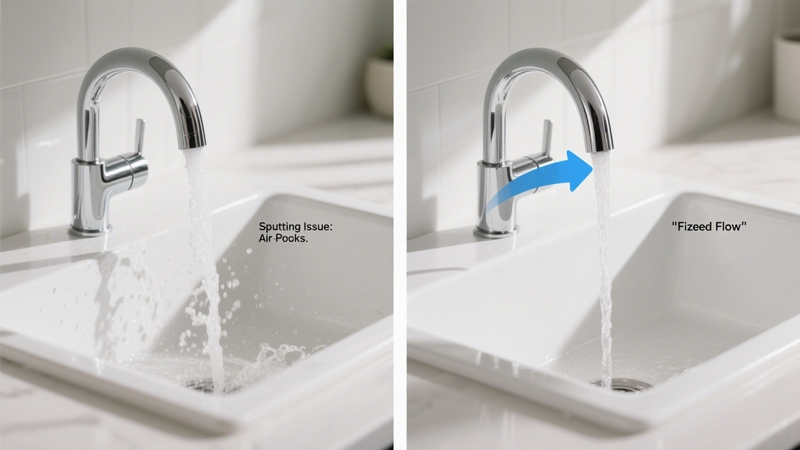
There’s nothing more frustrating than turning on a faucet expecting a smooth stream of water, only to be met with sputtering and spitting. A sputtering faucet isn’t just annoying—it’s often a sign of a deeper issue. Whether it’s a problem with air in the lines, sediment buildup, or something more serious, faucet sputtering can lead to wasted water, poor pressure, and even damage over time if left unaddressed.
In this post, we’ll walk you through the most common causes of faucet sputtering, how to diagnose the problem, and the steps you can take to fix it—most of which are beginner-friendly and don’t require a plumber.
What Does “Sputtering” Actually Mean?
Sputtering refers to inconsistent water flow—bursts of water interrupted by air or irregular pressure. You might hear gurgling, popping, or bubbling sounds. Sometimes water comes out in short, uneven spurts, and other times it sprays unpredictably.
Sputtering can affect:
- Hot water only
- Cold water only
- Both hot and cold
- All faucets in the house, or just one
Identifying when and where the sputtering occurs helps narrow down the root cause.
Common Causes of Faucet Sputtering
1. Air in the Water Lines
Air trapped in your pipes is one of the most common causes of faucet sputtering. This can happen after:
- A recent plumbing repair
- Water main maintenance by your local utility
- Draining your water heater
- A break in the water line
Signs:
- Sputtering in multiple faucets
- Occasional loud banging or “hammering” noises
- The issue resolves itself over time (in mild cases)
2. Sediment or Debris Buildup
Over time, minerals and rust from old pipes or a deteriorating water heater can break loose and flow into faucet valves and aerators. This debris can partially block water flow, creating sputtering and irregular pressure.
Signs:
- Reduced water flow in just one faucet
- Sputtering followed by weak pressure
- Visible debris in the aerator screen
3. Faulty Faucet Cartridge or Valve
Inside modern faucets is a cartridge or valve that controls water flow and temperature. If this internal component is worn out, misaligned, or partially clogged, it can cause irregular water delivery.
Signs:
- Sputtering isolated to a single faucet
- Handle feels loose or stiff
- Sputtering worsens when adjusting temperature
4. Air in a Well Water System (If Applicable)
If your home is on a well, air can be pulled into the water line due to low water levels, a failing pump, or a pressure tank issue. This leads to persistent sputtering, especially on the cold side.
Signs:
- Air bursts frequently from faucets
- Pump cycles on and off rapidly
- Sputtering worsens with water usage
5. Partially Closed Shut-Off Valve
The shut-off valves under your sink (or behind the wall) control water flow to each faucet. If one of them isn’t fully open, water may struggle to pass through, creating irregular flow.
Signs:
- Weak, sputtering water from one side (hot or cold)
- One faucet affected, others fine
- You recently had plumbing work done
Step-by-Step: How to Fix a Sputtering Faucet
Step 1: Determine If the Issue Is Widespread or Local
First, test all the faucets in your house:
- If all faucets sputter, especially after plumbing work, the cause is likely air in the main water line or issues with your well system.
- If just one faucet is sputtering, it’s probably a local issue (e.g., clogged aerator or valve).
Step 2: Flush the Line
If you suspect air or debris is trapped in the lines:
- Turn off the water supply to the sputtering faucet.
- Remove the aerator from the end of the faucet.
- Open both hot and cold handles (or mix lever).
- Turn the water supply back on and let it run for 1–2 minutes to flush out air and sediment.
- Clean the aerator and reinstall it.
Pro tip: Use a soft brush or soak the aerator in vinegar if it’s clogged with mineral buildup.
Step 3: Check the Shut-Off Valves
Look under your sink and check both hot and cold water shut-off valves. Make sure they’re fully open. If one is partially closed, turn it counterclockwise until it stops. Turn on the faucet again and observe the flow.
Step 4: Inspect the Cartridge or Valve
If sputtering persists and flushing didn’t help, the internal faucet cartridge might need cleaning or replacement:
- Turn off the water supply.
- Remove the faucet handle (usually with an Allen wrench or screwdriver).
- Extract the cartridge using pliers.
- Check for sediment buildup or visible damage.
- Clean or replace as needed (cartridges are usually model-specific).
Refer to your faucet’s manual or look up the model online if you’re unsure how to remove the cartridge.
Step 5: Address Well Water Issues (If Applicable)
For well systems:
- Check your pressure tank and make sure it maintains a steady psi.
- Inspect the well pump for signs of wear or failure.
- Contact a professional if air continues to enter the system regularly—this may indicate a cracked pipe or a suction issue.
Step 6: When to Call a Plumber
If none of these fixes work, or if you notice additional symptoms like discolored water, loud pipe noises, or visible leaks, it’s time to bring in a licensed plumber. Persistent air or pressure issues may stem from pipe corrosion, cracked supply lines, or problems in the main service line.
Preventing Future Sputtering
- Flush lines regularly if your water contains high sediment or minerals.
- Install a sediment filter for well water systems.
- Replace old or corroded piping if sputtering becomes common.
- Maintain your water heater, as sediment buildup can affect both hot and cold lines.
Final Thoughts
Faucet sputtering may seem minor at first, but it’s your plumbing’s way of signaling that something’s off—whether it’s air, sediment, or a failing part. With a little troubleshooting, most issues can be resolved quickly and without major expense. Don’t ignore sputtering, and always act early to keep your water flowing smoothly.
By understanding the causes and applying the right fixes, you can restore your faucet’s performance—and your peace of mind—in no time.
 ARCORA FAUCETS
ARCORA FAUCETS
